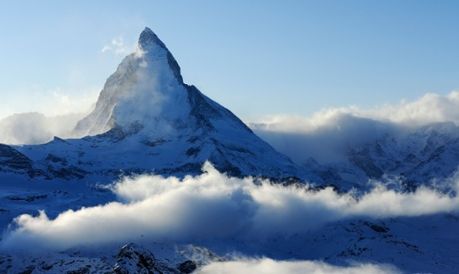It is by nothing more than an accident that Zermatt’s festivities this week have been attached to the name of Edward Whymper. Because he was the first man to climb the Matterhorn a hundred years ago on Wednesday, they have pegged their jollifications to that event. But essentially they have been celebrating their local benefactor.
Without the Matterhorn there would be no Zermatt as we know it today. There would not be so much varnish and lollipop-colored paint upon the houses. There would be no Whisky a Gogo, no Elsie’s Place to make the English feel dashing and comfortable in turn. It is doubtful whether there would still be so many picturesque stage coaches bowling guests from the railway station to their lodgings. Life in Zermatt would be altogether different and probably a sight duller.
The thousands who come to Zermatt each year do not limit themselves to the Matterhorn. Some of the greatest mountains in Switzerland are scattered around the village and they all get their share of attention. But the Matterhorn’s is the lion’s share. And the chances are that none of the others would have excited the interest they do if the Matterhorn had not been conquered and if there had not then been that dreadful accident on July 14, 1865. It is true that climbers had been pleasuring themselves in the Alps for some time before Whymper’s party got to the top. But this had been a private and clubbable thing to do. Like Scott’s journey to the Pole, Whymper’s venture was a high achievement capped by disaster. It captured the general imagination and it turned Alpinism into a more public pastime.
The Matterhorn is without a peer around Zermatt, though this has nothing to do with height. At 14,782ft it is lower than its neighbors Monte Rosa and Lyskamm. But as no competitor does, it dominates the horizon. There never was a more shapely mountain. It is a slim pyramid of rock which soars straight into the sky, and is operatic in its grandeur.
Along the ridge route that Whymper took there is little that a good climber in condition cannot tackle with confidence. The guides have even strung the most difficult bit near the top with fixed ropes to give everyone a hand. One day last year 175 people were to be observed testing themselves on the mountain. But a man has to be in condition to do this, for the altitude will turn his lungs into a furnace, the steepness will make his legs indiarubber, and if he slips without a rope to hold him he slips a very long way.
The Matterhorn must be in trim too. There are times even in high summer when snow and ice mean that none but the most brilliant can hope to get very far up Whymper’s route. There are other places on the mountain where only the best would dream of going at any time. A few months ago a man called Bonatti climbed the north-west face by himself. It took him four days and it had never been done before.

